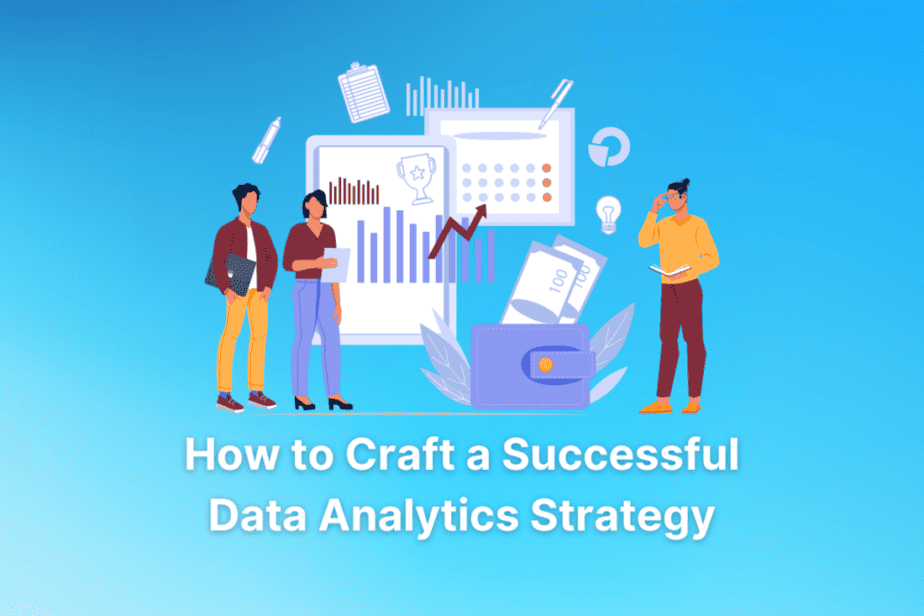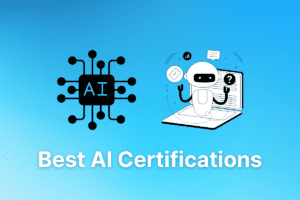How to Craft a Successful Data Analytics Strategy (Explained!)
We’re reader-supported; we may earn a commission from links in this article.
In today’s data-driven world, crafting a successful data analytics strategy is more crucial than ever.
It empowers businesses to make informed decisions, drive growth, and stay ahead of the competition.
This blog post will guide you through the essential steps in developing a data analytics strategy, from creating a data strategy roadmap to aligning analytics with business goals, and everything in between.
Let’s dive in!

Short Summary
- Create a data strategy roadmap to maximize value and remain competitive.
- Build an effective team with the right roles, develop data literacy culture, select appropriate tools & technologies.
- Align analytics with business goals by identifying KPIs. Monitor & iterate on your strategy for success.
The Importance of a Data Analytics Strategy for Businesses
A data analytics strategy is vital for businesses to make informed decisions, foster growth, and remain competitive in the market, ultimately driving business value.
This strategy consists of various components, including personnel, procedures, and tools necessary for supporting analytics initiatives.
Implementing a data analytics strategy enables businesses to make decisions based on data-driven insights, facilitating growth, and maintaining a competitive edge in the market.
The components of an effective data analytics strategy include:
- Recognizing specific business needs
- Aligning the data strategy with the business strategy
- Constructing a log of use cases
- Securing executive support
- Understanding the current analytics maturity level
A well-defined data strategy also serves as a guide for data engineers to make architectural decisions aligned with business objectives.
Moreover, an enterprise data strategy seeks to:
- Reduce bias by detailing the most suitable datasets for analytics
- Outline the training requirements for data operations personnel
- Establish an organization-wide data culture to boost data literacy and efficacy in utilization across the organization
- Upgrade data quality and precision of data gathering
- Create tailored training and learning pathways for collaborators.
1. Create a Data Strategy Roadmap
Creating a data strategy roadmap involves the following steps:
- Identify goals
- Evaluate the impact
- Prioritize actions
- Devise a plan to address gaps and enhance data maturity
By following these steps, you can develop an actionable data strategy and bridge any gaps in your organization’s data maturity.
Understanding one’s current analytics maturity level is beneficial in order to establish achievable objectives and take systematic, progressive measures to become more data-driven. Here are the steps to follow.
- Begin with the mission and objectives of the organization.
- Assess the strategic effect of data & analytics on those objectives.
- Rank action steps to reach business objectives through data & analytics objectives.
- Construct a data & analytics strategic roadmap.
- Execute that roadmap with a consistent and modern operating model.
By following these steps, you can improve your analytics maturity and become more data-driven.
Moreover, a data strategy roadmap plays a critical role in making architectural decisions that align with business objectives, such as selecting varied datasets for AI software and preventing the formation of unconscious bias within the software.
Operational planning is integral to the successful implementation of a data analytics strategy, ensuring that the strategy is followed through rather than being overshadowed by daily priorities.
2. Build a Strong Data Analytics Team
The establishment of a robust data analytics team is essential for the accomplishment of a data analytics strategy. A strong team is responsible for deploying technologies, adhering to standards, and communicating policy changes to relevant parties.
Assembling the right team members, fostering a data literacy culture within the organization, and implementing the right tools and technologies are key to achieving the desired outcomes in your analytics strategy and data and analytics initiatives.
a. Pick the Right Team Members
The initial step in creating a data analytics strategy is recognizing essential stakeholders, which is crucial for the success of the strategy. It is important to ensure that leaders do not prescribe the vision without input from business analysts or consumers.
Involving those with a vested interest in the data platform, enthusiasm for the use cases, and a long-term objective of making the organization more data-driven is essential for selecting the right team members.
Specific roles within the data analytics team include:
- Data engineers: responsible for constructing a dependable and efficient data architecture, supervising and administering data pipeline tasks such as data collection, processing, storage, and analytics, and enforcing data security and governance requirements.
- Data scientists: take the data processed by data engineers and utilize it for further analysis, leveraging the data to create various ML models and generate reports for business intelligence.
- Data analysts: responsible for analyzing data, identifying trends and patterns, and providing insights and recommendations based on the data analysis.
Data analysts specialize in:
- Interpreting and analyzing data
- Providing expertise to ensure that business intelligence tasks align with organizational requirements
- Collaborating closely with data scientists to ensure the successful execution of the strategy
- Ensuring the presence of different perspectives from the organization to provide input and maintain open communication with stakeholders.
b. Developing a Data Literacy Culture
Data literacy is the capacity to comprehend, generate, and communicate data in context, necessitating an awareness of data sources and structures, analytical methods and techniques, and the capability to articulate the use-case application and ensuing value.
Developing a data literacy culture within the organization is crucial for the success of a data analytics strategy, as it ensures that all team members can effectively utilize and analyze data.
Cultural changes, such as the need for employees to adjust their mindset, can be more substantial than technical challenges and can be intimidating.
To foster data literacy, prioritize the change management component of the data and analytics strategy, leverage leadership and change agents, and address both data literacy skills and culture.
Establishing a data literate culture will enable team members to make better data-driven decisions, leading to improved business outcomes.
Data storytelling is a technique used to frame data and insights into data-driven stories, allowing stakeholders to easily interpret, understand, and act on the information being shared.
This approach can create positive, impactful stakeholder engagement, and further promote a data-driven culture within the organization.
3. Select the Right Tools and Technologies
Selecting the right tools and technologies for data analytics is a crucial aspect of a successful data analytics strategy.
It involves evaluating existing infrastructure, recognizing any discrepancies, and selecting solutions that are compatible with business needs and compliance regulations.
A comprehensive evaluation of the need for a suitable proof of technology can provide a better understanding of how the proposed tools meet the selection criteria.
A data strategy facilitates the identification of tools that both fulfill business requirements and support both IT teams and business users.
For instance, data catalog tools can assist in the identification and categorization of existing data assets.
Choosing the right tools is of paramount importance for a successful analytics program, as it has a direct impact on costs and final analysis.
When selecting a BI platform, it is important to consider the following factors:
- The tool should be straightforward to learn
- It should furnish the required connection types for potential use cases
- It should be equipped with the required security standards
- The team should be enthusiastic about utilizing it
By carefully considering these factors, businesses can ensure they choose the right tools and technologies to drive their data analytics strategy forward.
4. Ensure Data Governance and Quality Management
Ensuring data governance and quality management is a key aspect of a successful data analytics strategy. It involves establishing a data governance framework and ensuring data quality to guarantee accurate and reliable analytics.
Effective data and analytics governance requires a balance between enterprise-wide and business-specific governance, in accordance with the D&A strategy.
a. Implementing Data Governance Framework
A data governance framework is a comprehensive set of standards, guidelines, protocols, processes, and rules designed to facilitate effective management of data assets.
It outlines roles, responsibilities, and processes for ensuring accountability and ownership of data assets across the organization. Implementing a data governance framework involves defining decision rights, accountability, and processes to ensure appropriate data usage and management.
Establishing decision rights involves determining who has the authority to make decisions regarding data usage and management.
Defining accountability involves assigning responsibility for data usage and management to specific individuals or teams. To ensure appropriate data usage and management, protocols and rules for data access, storage, and usage must be established.
Data governance roles are responsible for deploying applicable technologies, adhering to established standards, and communicating policy changes to relevant parties.
An effective data strategy can improve data security by implementing measures to restrict unauthorized data access, ensuring that enterprise data management maintains the privacy, security, and integrity of data at all times.
b. Ensuring Data Quality
Data quality is a concept that encompasses the following aspects of data:
- Accuracy
- Completeness
- Consistency
- Reliability
It is a critical component of data management and analytics. Ensuring data quality involves establishing processes and standards to maintain the accuracy, consistency, and reliability of data used in analytics.
Data quality is paramount as it guarantees that the data utilized in analytics is precise, uniform, and dependable, aiding in ensuring that the outcomes of the analytics are reliable and can be trusted.
Implementing measures to guarantee data quality involves establishing processes and standards for data collection, storage, and analysis; monitoring data quality, and regularly auditing data quality.
By maintaining data quality, businesses can ensure that their data analytics strategy yields accurate and reliable insights, driving informed decision-making and improved business outcomes.
In addition to implementing measures to ensure data quality, it is also important to consider performance in comparison to competitors and industry benchmarks.
Regularly measuring and tracking KPIs over time is essential to recognize trends and areas of improvement, allowing businesses to continuously refine their data analytics strategy and drive success.
5. Aligning Data Analytics with Business Goals
Aligning data analytics with business goals is crucial for driving growth and success. By identifying key performance indicators (KPIs) and setting clear, measurable objectives, businesses can ensure that their data analytics strategy is focused on achieving the desired outcomes and driving business value.
Data analytics can help businesses identify trends, uncover insights, and make informed decisions. It is.
a. Identifying Key Performance Indicators (KPIs)
Key Performance Indicators (KPIs) are quantifiable values that indicate how successfully a company is reaching its main business objectives. KPIs provide a method to evaluate progress towards crucial business objectives and identify areas for enhancement.
When selecting KPIs, it is essential to focus on metrics that are pertinent to business growth and have a direct influence on the bottom line, as well as considering the data sources available and the resources necessary to track the KPIs.
Regularly measuring and tracking KPIs over time is essential to recognize trends and areas of improvement. By focusing on the most relevant KPIs, businesses can ensure that their data analytics strategy is aligned with their overall business objectives, driving growth and success.
Moreover, it is important to consider performance in comparison to competitors and industry benchmarks when measuring KPIs.
This approach allows businesses to identify areas where they are excelling or lagging behind, enabling them to make data-driven decisions to improve their performance and achieve their business goals.
b. Setting Clear and Measurable Objectives
Setting clear and measurable objectives is an essential aspect of a successful data analytics strategy. These objectives should be specific, achievable goals that align with the overall business strategy and can be tracked and measured over time.
The SMART framework, which stands for Specific, Measurable, Achievable, Relevant, and Time-bound, is a widely-used approach for setting measurable objectives.
Examples of measurable objectives include reducing product defects by 20% within the next six months or enhancing customer satisfaction by 15% through product improvements and customer feedback.
By setting clear and measurable objectives, businesses can ensure that their data analytics strategy is focused on achieving the desired outcomes and driving business value.
Regularly reviewing and adjusting objectives as needed is crucial for ensuring that the data analytics strategy remains aligned with business goals and continues to drive growth and success.
This process involves monitoring KPIs, making data-driven decisions, and maintaining open communication with stakeholders to ensure continuous improvement.
6. Monitoring and Iterating on Your Data Analytics Strategy
Monitoring and iterating on your data analytics strategy is crucial for ensuring its continuous success.
This involves consistently tracking and assessing the effectiveness of the strategy to guarantee that it is achieving its desired outcomes. Analyzing key performance indicators (KPIs) and making adjustments to the strategy as needed allows businesses to refine their approach and continue driving growth and success.
Maintaining open communication with stakeholders is essential for keeping everyone informed about the current state of the data analytics strategy and any changes that may be implemented.
To ensure open communication, the following practices should be employed:
- Regular meetings to discuss progress and updates
- Providing frequent updates on the status of the data analytics strategy
- Establishing feedback loops to gather input and address concerns
By implementing these practices, all parties involved will be aware of the current state of the data analytics strategy and any changes that may be implemented.
By regularly reviewing and adjusting the data analytics strategy, businesses can ensure that it remains aligned with their overall business objectives and continues to drive growth and success.
This process involves monitoring KPIs, making data-driven decisions, and maintaining open communication with stakeholders to ensure continuous improvement and success.
Summary
In conclusion, crafting a successful data analytics strategy is essential for businesses to stay competitive, drive growth, and make informed decisions.
By following the steps outlined in this blog post, from creating a data strategy roadmap to aligning data analytics with business goals and monitoring and iterating on the strategy, businesses can ensure that they are leveraging the power of data analytics to achieve their desired outcomes.
With a well-executed data analytics strategy in place, businesses can unlock their full potential and thrive in today’s data-driven world.
Frequently Asked Questions
Why have a data strategy?
A data strategy enables businesses to make informed decisions, innovate and maximize their data assets. With the right strategy, companies can strengthen their financial performance, increase productivity and remain competitive.
What is strategic data?
Strategic data involves industrial information such as entry barriers, supplier and buyer power, ability of consumers to substitute the product, and number of competitors.
This data is used to gain insights into the business’s competitive position in an industry.
How to develop a data strategy?
To develop a data strategy, understand your business objectives and assess the current state, then create a framework that connects data and AI to business strategy, establish controls, integrate solutions, and scale team and processes.
This framework should include a plan for data collection, storage, and analysis, as well as a strategy for leveraging AI and machine learning to drive insights and decision-making. Additionally, it should include a plan for governance and security, as well as a roadmap for implementation and scaling.
What are the key components of a data analytics strategy?
Creating a successful data analytics strategy requires personnel, procedures and the right tools to support analytics initiatives.
What roles are essential for building a strong data analytics team?
Successful data analytics teams require skilled professionals in roles such as data engineers, scientists, and analysts, each of whom brings unique expertise to their work.
Data engineers are responsible for designing, building, and maintaining data systems. They must be able to understand the data architecture and develop efficient data pipelines. Data scientists use their knowledge of mathematics, statistics, and computer science to analyze data and develop applications.

Justin Chia
Justin is the author of Justjooz and is a data analyst and AI expert. He is also a Nanyang Technological University (NTU) alumni, majoring in Biological Sciences.
He regularly posts AI and analytics content on LinkedIn, and writes a weekly newsletter, The Juicer, on AI, analytics, tech, and personal development.
To unwind, Justin enjoys gaming and reading.



